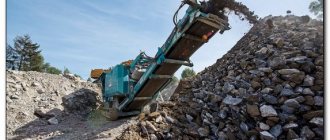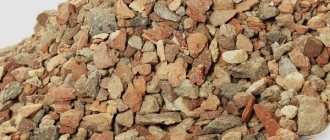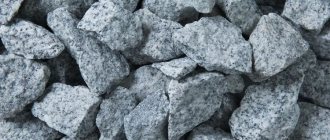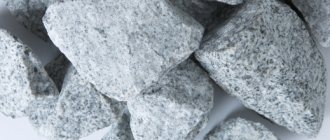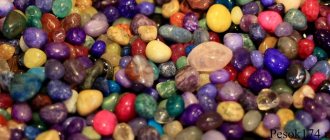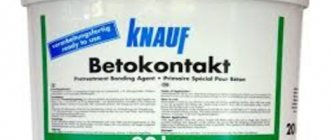Crushed gravel. Photos of Soil Trucks
Among the wide range of types of crushed stone, gravel is of particular interest. This building material is distinguished by its affordable cost and high performance.
It is the positive characteristics that ensure increased demand among construction organizations and private clients.
Extraction, processing, production
Mining of crushed stone is carried out in industrial quarries, which have a wide geography. Gravel quarries are located in many countries, including Russia. The Ermolinsky, Petrovsky, Ivanovsky, and Karelian quarries are well known. A significant number of quarries located in different regions ensure low costs for transporting materials to consumers and/or to the point of sale.
The extraction process begins with surface preparation , clearing of grass, earth, and sand. Cleaning is done by drilling and blasting with low force. As a result, rock is exposed, which serves as raw material for the production of crushed stone, which is blasted several times.
The material extracted from the quarry has impurities that affect its quality. In order to improve the characteristics, sieving is performed, which is carried out using massive sieves and is the first stage of processing. After sifting, the rock fractions undergo a crushing procedure ; rotary crushers are most often used as equipment. Then the crushed mass again goes through the process of sorting by size , for this purpose special industrial sieves with cells of different sizes are used. As a result, the material is divided into separate groups according to fraction sizes. Finished products are packaged and transported.
Characteristics: bulk density and others
The characteristics inherent in crushed gravel make the material in demand. Each type of crushed stone has the same characteristics, but their indicators differ:
- Frost resistance is the ability of a material to resist structural destruction and mass loss as a result of repeated cycles of freezing and thawing. For crushed gravel the indicator is F150, i.e. the material can withstand up to 150 cycles of freezing and subsequent thawing.
- Strength. Crushed gravel is slightly inferior only to its granite counterpart. The strength of the rock is M800-M1000.
- Flakiness is a parameter that demonstrates the number of fractions of needle-shaped and plate-shaped forms that make it difficult to densely pour crushed stone. That is, the lower this indicator, the better. For crushed gravel, the flakiness is 7-17%.
- density , like bulk density, depends on the size of the fractions; the average for crushed gravel is 2400 m/cub.kg and 1300 kg/cub.m.
- Adhesion is a characteristic that shows how well the surface of crushed stone adheres to solutions. Crushed gravel has a high degree of adhesion, which guarantees high strength of the final product.
- Radioactivity. Crushed gravel belongs to the products of the first class of radioactivity. Thus, the material is suitable for the construction of buildings for various purposes, including residential buildings and public facilities.
What else is useful to know about crushed stone
Any construction requires correct calculation of material consumption. To determine how many cubes are in one ton of crushed stone with a fraction of 5-20 mm, you need to know the bulk density of the material or its volumetric weight. Let's take the average figure - 1350 kg/m3, divide 1000 kg by 1350 and find that a ton of material fits into 0.7407 m3.
If you need the opposite result, that is, to understand how much a cube of crushed stone weighs, then this is the value of the density or mass of the material in bulk.
In addition, when making calculations, it is necessary to take into account such an indicator as the compaction coefficient of crushed stone during compaction and transportation. For preliminary calculations, you need to take standard values from GOST, for example, in the case of using granite crushed stone, the coefficient is 1.1.
Under construction site conditions, special equipment is used to determine this indicator, and the decision is made by construction laboratory specialists based on the results of experimental measurements of the resistivity of the material.
Advantages and disadvantages
Some of the characteristics presented above can be considered as advantages of crushed gravel: low flakiness and level of radioactivity, high resistance to impacts and temperature changes. It is also possible to note other positive features of crushed gravel:
- affordable price;
- functionality, possibility of application in many areas: from concrete production to construction of structures;
- good appearance, which allows the use of crushed stone for decorative purposes;
- completely environmentally friendly, has no harmful impurities, natural origin.
The only drawback that can be noted is the not very outstanding strength indicators. In addition, some unscrupulous enterprises deliver gravel to customers instead of crushed gravel, and sell unwashed crushed stone with admixtures of sand and clay.
Characteristics of crushed stone
We list the main indicators that are inherent in all types of crushed stone:
- density;
- frost resistance;
- radioactivity;
- fraction;
- flakiness;
- strength.
The indicators that people always pay attention to are fraction, strength and frost resistance. Fraction is the grain size; it is this indicator that is often the key when choosing construction crushed stone. Factions are:
- small – 5 mm – 20 mm;
- medium – 20 mm – 40 mm;
- large – 40 mm – 70 mm;
- screening – about – 5 mm.
During the production of crushed stone, it is sorted by sifting through special sieves according to the size of the stones. Thus, crushed stone is selected and separated into fractions. Frost resistance is an important factor that depends on the method of origin of the source material - it could be sea pebbles, granite rocks or a limestone quarry. Crushed stone has a rough surface and pores into which moisture enters. With the arrival of sub-zero temperatures, moisture tries to tear the stone, and this is fraught with consequences. The more pores, the greater the likelihood of the object being built. Crushed granite has the highest rate; the number of freezing and thawing cycles is maximum permissible. The object, with its use, will stand for many years without any special influences from an aggressive external environment. Radioactivity is an indicator that is taken into account during housing construction, with special attention to hospitals and children's institutions. If the original rocks of the stone lay at great depths, there is always a special type of gas, which, when measured, shows the radioactivity of the crushed stone. In some cases, the crushed stone needs to sit for some time to reduce harmful radiation. Limit values for the granite variety of crushed stone. Flakiness is essentially the shape of the pebbles, which affects the bulk density and strength of the structures being built. The shape of the pebbles can be cuboid, needle-shaped, rounded, flat. Cuboid crushed stone is most in demand in all works; it has the highest bulk density, regardless of the fraction and type of crushed stone. Other forms of crushed stone do not provide the density of the concrete mass; voids form inside it, which negatively affect the strength of the object being built. In numerical designation, the lower the number, the better the flakiness, i.e. filling. Strength is an important indicator that depends on the method of extraction of the source material and its origin. Granite rocks and crushed stone have the highest strength levels. Limestone material has the least strength, but is also widely used in various construction works. The world knows ancient buildings made of limestone rocks that attract tourists to this day.
Areas of application
Crushed gravel has found application in many areas, in particular:
- road construction; crushed stone is a mandatory element in the organization of the roadway, during its repair and reconstruction; it is an indispensable material in the construction of driveways and pedestrian paths, parking lots, and sidewalks;
- construction of buildings for various purposes as a reinforcing element of foundations;
- railway construction, during the construction of railway embankments;
- landscape design , to solve problems in this direction: creating decorative objects, garden and park paths, designing flower beds - it is recommended to use smooth crushed stone, the material is successfully used in the construction of drainage systems;
- production of concrete and reinforced concrete products;
- construction of bridges and other massive structures.
It is highly recommended to use crushed gravel when constructing radioactive structures, since the material has low radioactivity.
Types of gravel and granite crushed stone by fractional composition
When talking about what types of crushed stone there are, we should not forget about its fractional division. Depending on the source raw material, this or that crushed stone is produced in several types of fractions. Granite and crushed gravel are the most common in construction.
Crushed gravel of a fraction of 3-10 mm is used for screening, 5-20 mm is used in the production of small-sized construction products (paving slabs, etc.), 20-40 mm - for larger monolithic products (for example, rings for a well) . Crushed gravel of 20-40 mm fraction is widely used for the production of various concrete and reinforced concrete structures.
Granite crushed stone has a more diverse fractionation. Depending on the type of granite crushed stone fraction, its application also depends. For example, a fraction of granite crushed stone of 5-20 mm is considered small and is widely used for monolithic construction.
Crushed stone of medium fraction 20-40 mm is also excellent for concrete and the production of reinforced concrete structures. The coarse fraction of 20-40 and 40-70 mm is appropriate when it is necessary to produce large volumes of concrete, as well as for pouring large, massive structures. Such crushed stone is suitable for the construction of industrial facilities and highways. Fractions of granite crushed stone 70-120, 120-150, 150-300 can also be called rubble. Such crushed stone is usually used for more decorative purposes. For example, for the construction of stone fences and hedges. The smallest fraction of granite crushed stone 0-5, 0-20, 0-40 mm is widely used in road construction.
Differences between granite and gravel
There is a fairly significant number of types of crushed stone, some are discussed in detail on our website: limestone, dolomite, marble, black, decorative, slag, basalt, expanded clay, recycled, foam glass. However, most often crushed gravel is compared with granite . The extraction and production of materials is carried out using the same technology. However, there are some differences. As mentioned earlier, crushed gravel is inferior to granite in strength . In accordance with the key characteristics, it is possible to note the following advantages of one of the materials:
- gravel has a more affordable price, which allows you to reduce costs when implementing projects, in particular large-scale ones;
- gravel has less radioactivity;
- gravel is slightly inferior, but inferior in terms of flakiness and frost resistance.
Granite crushed stone. Photo Petrovich
Gravel, unlike crushed gravel, is a product of natural influences. Layers and rocks are weathered, destroyed and crumbled. Gravel fractions are collected by special mechanisms, sieved, sometimes washed to remove foreign impurities, and crushed. Gravel can be not only mountain, but also river, sea, and lake. As a result, the shape of the gravel is smoother , neater, without sharp corners. Accordingly, the material has a more attractive appearance and the ability to perfectly fill voids. But at the same time, gravel has the worst adhesion index. The cost of materials is approximately the same. Gravel comes in a wide variety of colors.
The sizes of gravel grains differ from the “dimensions” of crushed stone fractions. In this case, it is difficult to get ahead of whether this is a plus or a minus, it all depends on the tasks set. In general, it can be noted that gravel is more often used to solve decorative problems, and crushed stone is used for the production of concrete, reinforced concrete products and other, so to speak, practical products.
Types of crushed stone by origin
Depending on what rock the material was made from, the following types of building crushed stone are distinguished:
- granite;
- gravel;
- limestone (dolomite);
- slag;
- slate;
- secondary.
Granite crushed stone is produced on the basis of granite rock mass. As a rule, this type of crushed stone has a reddish color and uneven edges. However, this only improves the ability to adhere to the cement mortar in the concrete mixture, which ensures good strength characteristics.
Currently, several types of granite crushed stone are produced depending on the fraction. The “grinding” size of crushed granite can vary from 0-5 mm to 70-120 mm. Granite crushed stone is a widely popular building material due to its excellent technical characteristics. Depending on the fractional composition, granite crushed stone is used in various fields.
Crushed gravel is obtained by sifting quarry rocks, or by explosive method in the development of rocks. Crushed stone is a grayish mass of various fractional compositions. To produce crushed stone, they are guided by GOST 8267-93, which specifies the required technical characteristics of the material and production technology. Compared to granite, crushed gravel has less strength, which determines the scope of its application.
The highest strength grade of crushed gravel is only M 1200. Although crushed gravel is inferior to granite in such characteristics as strength and appearance, it has a fairly large number of advantages. The process of extracting crushed gravel is much easier than granite and requires less effort and money. The fact is that rocks are less durable compared to granite, which means that their development will require less powerful equipment and machines. In addition, gravel is considered a very common material, which also leads to a relatively low cost of the material.
The prevalence of “deposits” of crushed gravel contributes to great competition in the extraction of this material, which also reduces its market value. Crushed gravel has a lower radioactive background than granite. Crushed gravel is produced in four fractions: 3-10 mm, 5-20 mm, 5-40 mm, 20-40 mm.
Limestone (dolomite) crushed stone , as a rule, is used in construction in lightly loaded structures. It can be used for the production of piece products from reinforced concrete, provided that no heavy load is placed on these parts. Crushed limestone is a product of crushing sedimentary rocks, consisting mainly of calcium carbonate. Limestone crushed stone is mined in quarries. The material is quite widespread, so crushed limestone is quite inexpensive.
Limestone crushed stone has low strength, so its scope of application is much narrower than that of granite or gravel. Crushed stone is widely used in road construction when laying roads with low loads. Limestone crushed stone is also widely used in the production of lime, soda and mineral fertilizers. Lime crushed stone is produced in three types of fractions, which determine the scope of their application. Crushed limestone is produced in fractions of 5-20 mm, 20-40 mm and 40-70 mm.
Slag crushed stone is an affordable building material obtained from waste from the metallurgical and chemical industries, as well as from the combustion of solid fuels. Slag crushed stone has a high density. Its density is higher than that of granite crushed stone. However, high density characterizes a large mass of material, which is a rather significant drawback in construction. Slag crushed stone has a higher water absorption coefficient compared to granite. Therefore, structures built with such crushed stone should not often come into contact with moisture.
Slag crushed stone should also not be subjected to frequent freezing, because the frost resistance characteristics of this material are very small (only 15 cycles versus 300 cycles of granite crushed stone). The use of crushed slag stone is advisable if all its shortcomings are fully taken into account. In general, depending on the fraction (0-5, 5-20, 20-40, 40-70, 70-120 mm), slag crushed stone is often used in civil and road construction, as well as in the production of building materials.
Crushed shale is a material obtained from rocks of volcanic origin. Externally, crushed shale will look like a mound of oblong, flat stone. The color of crushed slate can be burgundy, yellow, brown, grey, anthracite or green. Shales are widely used in construction and materials production. For example, there is a type of shale, when split, many thin plates are formed. Such slates are used for roofing materials.
The product of shale crushing, crushed stone, is also widely used in construction. Crushed shale is used for the construction of roads and monolithic reinforced concrete structures, as well as for landscape decoration. Depending on the faction, crushed slate stones are used to decorate the decorative elements of the surrounding area and create interesting paths. However, it should be taken into account that before choosing a specific fraction and type of shale crushed stone, it is necessary to study its characteristics in detail.
Currently, so-called secondary crushed stone is quite common. It is obtained by crushing construction waste. Secondary crushed stone is produced by crushing monolithic structures, having previously removed the reinforcing frame and metal embedded parts from them during the primary split.
Recycled crushed stone, due to its relatively low cost, has a very cheap price. So, for example, when compared with granite, recycled crushed stone from construction waste will cost about half as much. The cost of concrete produced from recycled crushed stone will be reduced by up to 30% compared to mixtures made with granite aggregate. However, such low cost of the material also indicates its reduced strength and frost resistance. The maximum grades for strength and frost resistance of secondary crushed stone are M800 and F150, respectively. However, even with such indicators, recycled crushed stone can be used in various fields.
On the stroyka.ru portal you can study information on types of crushed stone with color photos of the materials presented, as well as find out where to buy crushed stone at the lowest price.
Kinds
Crushed gravel, which is one of the types of bulk materials according to its origin, is also divided into several types, in accordance with the criteria presented below.
Stamps
Crushed gravel 5-20. Photo by Leroy Merlin
There are several grades of crushed gravel according to strength:
- high-strength M1200;
- durable M800-M1000;
- medium strength M600-M800;
- low strength M300-M600;
The number after the letter “M” in the marking reflects the percentage of grains obtained from weak rocks. For each type of crushed stone it is:
- M1000-M1200 - from 1 to 5%;
- M600-M800 - no more than 10%;
- M300-M400 - no more than 15%.
Knowing the brand of crushed stone allows you to determine which crushed stone is suitable for performing certain jobs. Thus:
- M300 and M400 can be used to create lightweight concrete structures; the materials are in demand among small construction companies;
- M600, M800 and M1000 are most often used in the construction of roads with relatively light loads and the construction of small concrete structures;
- high-strength crushed stone is used in the organization of foundations and in the construction of critical structures.
Fractions: 20-40, 5-20 and others
Crushed stone is divided into separate groups according to grain sizes. The material of each category is recommended to be used to solve specific problems. There are three main factions:
- fine 5-20 - used for the production of concrete and small concrete structures, the creation of floor slabs and bridge elements, for the repair and construction of roads, for filling paths;
- 20-40 — the middle fraction is in greatest demand and is used for pouring foundations, manufacturing concrete and structures from it, building highways and railways, sprinkling tracks, and constructing drainage systems and drainage systems;
- large 40-70 - especially in demand when constructing foundations for concrete structures, in road construction, and is most actively used in the construction of monolithic buildings.
Often crushed stone 3-10 is classified as a separate category, used in landscape design; it can be successfully used for paving paths, the bottom of reservoirs, and decorating areas.
Screening of crushed stone 0-5 mm in size. is used when performing landscape work, and also as an anti-icing agent. More information about what screenings, chips and crushed stones are is presented in a separate article.
Mass, how much does a cube weigh?
The calculation of the required volume and weight of materials is carried out at the preliminary stage of work. Crushed stone is sold in kilograms/tons, and to implement projects it is necessary to know the volume of material. Weight 1 cubic meter crushed stone depends on several factors: stone type, fraction, flakiness, humidity, density.
The last parameter is very difficult to determine, since crushed stone is a bulk material with voids between the grains. Therefore, the larger the fraction, the more voids between the grains, the less the weight of one cube. That is, weight is most influenced by fraction and density . There are average data on the weight of one cube of crushed stone of different fractions:
- 0-5 mm. — 1.50 t.;
- 5-10 — 1.45;
- 5-20 — 1.37;
- 20-40 — 1.41;
- 40-70 — 1.47;
- 70-120 — 1.48.
The data allows you to calculate the required weight of crushed stone. For example, a buyer needs crushed stone 20-40 in the amount of 10 cubic meters, the calculations will be as follows:
1.41 x 10 = 14.1 tons or 14100 kg.
There is an error in the calculations, it is about 10%, so it is recommended to purchase crushed stone with a small margin.
Packing: in bags and more
Crushed gravel is sold by ton, by weight, without packaging. Crushed stone is also available for sale in bags weighing from 20 to 50 kg and big bags - soft containers with a capacity of one ton.
Crushed gravel fraction 5-20 1000 kg. Photo by Leroy Merlin
Types and technical characteristics
The main properties of bulk building material directly depend on the quality characteristics of the feedstock and the results of crushing plants. Crushed stone obtained from the processing of dense rocks must comply with the requirements of GOST 8267-93. When producing crushed stone from low-strength and porous stones, they are guided by the provisions of GOST 22263-76, but if blast furnace slag is used as the raw material, then the main document is GOST 18866-93. Each category of building crushed stone is assigned a name corresponding to the rock or material from which it was made.
Granite crushed stone fraction 5-20
By crushing granite, high quality bulk material is obtained, having:
- uniform cubic grain shape;
- the lowest percentage of flakiness (7-15%);
- good frost resistance - can withstand up to 400 freezing/thawing cycles;
- significant volumetric weight of granite crushed stone – 1600 kg/m3;
- excellent adhesion to all types of binders and mastics;
- low level of water absorption – 0.2% by weight;
- The bulk density of granite crushed stone 5-20 is in the range of 1400-1600 kg/m3.
There is also such a thing as the true density of crushed stone. This value is determined in the dense state of the material, without taking into account voids. In our case, it is equal to 2600 kg/m3.
The listed characteristics plus a high compressive strength - from 800 to 1400 kg/cm2 - made granite crushed stone fr. 5-20 is indispensable in the manufacture of critical concrete and reinforced concrete structures, including those with prestressing reinforcement. In addition, granite crushed stone has found application in the construction of airfield structures, road and railway bridges. It is used by landscape designers to decorate their garden plots in their natural form or painted.
Limestone crushed stone fr. 5-20 mm
In terms of strength indicator (M400-M800), this type of bulk aggregates, along with dolomite crushed stone, is inferior to other types. Almost the same raw materials are used for their production. Main parameters of crushed limestone:
| Strength grade, (M) | from 400 to 800 |
| Frost resistance, (F) | from 50 to 150 |
| Radioactivity, class | 1 |
| Bulk weight, t/m3 | from 1.26 to 1.32 |
Both dolomite and limestone crushed stone are treated with special chemical compounds during the production process. Stones measuring 5-20 mm are used in the construction of non-load-bearing reinforced concrete structures, for the construction of strip foundations for light structures, in metallurgy and glass production. Larger fractions have found use in road construction.
Crushed gravel fr. 5-20
From the very definition of the material it is clear that this type of bulk material is obtained by grinding and sifting coarse gravel. The strength indicators of this material are slightly lower than those of granite crushed stone. Therefore, the remaining characteristics are very similar, for example, the specific gravity of crushed stone of fraction 5-20 from gravel and granite is 2500-2600 kg/m3. It is used for preparing molding mixtures, but for concrete grades not higher than M350.
The main feature of crushed gravel is its decorative effect and pleasant tactile sensations. Therefore, landscape designers love it, including for arranging beach areas.
Many amateur builders, and even sellers of bulk materials, use buckets as a measuring stick. Then the natural question arises, how much does a bucket of gravel or crushed stone weigh? The answer is simple: if the weight of 1 m3 of crushed stone in bulk is 1400 kg, then a 12-liter bucket will hold from 16 to 20 kg.
Marble crushed stone
This material is absolutely environmentally friendly, endowed with a wide range of colors. Due to the property of being easy to machine, for example grinding or polishing, it is used for the device:
- marble and mosaic floor coverings;
- lining of swimming pools, basements of buildings, gazebos, various garden decor items.
In addition, crushed marble is used to make crumbs of different sizes for filling decorative mixtures and coloring compositions.
Crushed slag stone 5-20
This type of filler is made from waste from metallurgical enterprises. It is used as crushed stone for concrete in the production of reinforced concrete products, paving slabs, cinder blocks, thermal insulation materials, and asphalt concrete.
We will see the characteristics of various types of slag crushed stone in comparison with granite in the following table:
| Raw material type | True density, kg/m³ | Average density, kg/m³ | Moisture absorption by mass,% | Compressive strength, MPa | Crushingability indicator, % |
| Granite | 2650 | 2650 | 0,2 | 120 | 11 |
| Slags: | |||||
| dense domain | 2950 | 2820 | 1,5 | 104 | 19 |
| porous | 2940 | 2300 | 7,3 | 62 | 44 |
| open hearth | 3200 | 3030 | 2,3 | 110 | 17 |
| converter | 3100 | 2800 | 4,0 | 76 | 39 |
| copper smelting | 3500 | 3430 | 0,4 | 140 | 6 |
| phosphorus | 2950 | 2850 | 0,9 | 135 | 12 |
The volumetric weight of crushed stone from slag is in the range of 1000-1500 kg/m3.
